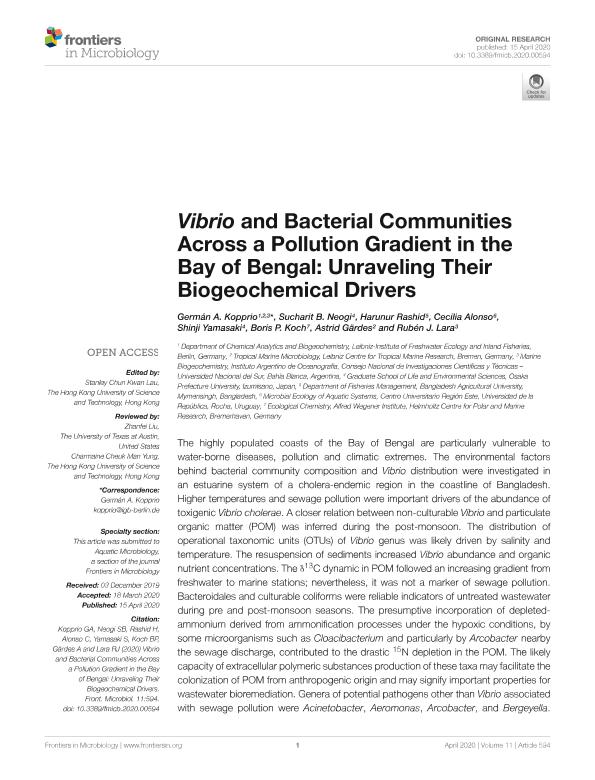Artículo
Vibrio and Bacterial Communities Across a Pollution Gradient in the Bay of Bengal: Unraveling Their Biogeochemical Drivers
Kopprio, Germán Adolfo ; Neogi, Sucharit Basu; Rashid, Harunur; Alonso, Cecilia; Yamasaki, Shinji; Koch, Boris Peter; Gärdes, Astrid; Lara, Ruben Jose
; Neogi, Sucharit Basu; Rashid, Harunur; Alonso, Cecilia; Yamasaki, Shinji; Koch, Boris Peter; Gärdes, Astrid; Lara, Ruben Jose
 ; Neogi, Sucharit Basu; Rashid, Harunur; Alonso, Cecilia; Yamasaki, Shinji; Koch, Boris Peter; Gärdes, Astrid; Lara, Ruben Jose
; Neogi, Sucharit Basu; Rashid, Harunur; Alonso, Cecilia; Yamasaki, Shinji; Koch, Boris Peter; Gärdes, Astrid; Lara, Ruben Jose
Fecha de publicación:
15/04/2020
Editorial:
Frontiers Media S.A.
Revista:
Frontiers in Microbiology
ISSN:
1664-302X
Idioma:
Inglés
Tipo de recurso:
Artículo publicado
Clasificación temática:
Resumen
The highly populated coasts of the Bay of Bengal are particularly vulnerable to water-borne diseases, pollution and climatic extremes. The environmental factors behind bacterial community composition and Vibrio distribution were investigated in an estuarine system of a cholera-endemic region in the coastline of Bangladesh. Higher temperatures and sewage pollution were important drivers of the abundance of toxigenic Vibrio cholerae. A closer relation between non-culturable Vibrio and particulate organic matter (POM) was inferred during the post-monsoon. The distribution of operational taxonomic units (OTUs) of Vibrio genus was likely driven by salinity and temperature. The resuspension of sediments increased Vibrio abundance and organic nutrient concentrations. The δ13C dynamic in POM followed an increasing gradient from freshwater to marine stations; nevertheless, it was not a marker of sewage pollution. Bacteroidales and culturable coliforms were reliable indicators of untreated wastewater during pre and post-monsoon seasons. The presumptive incorporation of depleted-ammonium derived from ammonification processes under the hypoxic conditions, by some microorganisms such as Cloacibacterium and particularly by Arcobacter nearby the sewage discharge, contributed to the drastic 15N depletion in the POM. The likely capacity of extracellular polymeric substances production of these taxa may facilitate the colonization of POM from anthropogenic origin and may signify important properties for wastewater bioremediation. Genera of potential pathogens other than Vibrio associated with sewage pollution were Acinetobacter, Aeromonas, Arcobacter, and Bergeyella. The changing environmental conditions of the estuary favored the abundance of early colonizers and the island biogeography theory explained the distribution of some bacterial groups. This multidisciplinary study evidenced clearly the eutrophic conditions of the Karnaphuli estuary and assessed comprehensively its current bacterial baseline and potential risks. The prevailing conditions together with human overpopulation and frequent natural disasters, transform the region in one of the most vulnerable to climate change. Adaptive management strategies are urgently needed to enhance ecosystem health.
Archivos asociados
Licencia
Identificadores
Colecciones
Articulos(IADO)
Articulos de INST.ARG.DE OCEANOGRAFIA (I)
Articulos de INST.ARG.DE OCEANOGRAFIA (I)
Citación
Kopprio, Germán Adolfo; Neogi, Sucharit Basu; Rashid, Harunur; Alonso, Cecilia; Yamasaki, Shinji; et al.; Vibrio and Bacterial Communities Across a Pollution Gradient in the Bay of Bengal: Unraveling Their Biogeochemical Drivers; Frontiers Media S.A.; Frontiers in Microbiology; 11; 15-4-2020; 1-16
Compartir
Altmétricas



